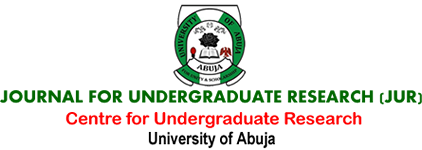About
Journal for Undergraduate Research (JUR) is an international multidisciplinary biannual publication of the Centre for Undergraduate Research, University of Abuja. It is an Open Access Peer-Reviewed Research Journal that publishes original research and innovations by undergraduate students globally.
Scope
JUR publishes original research in the management, arts and humanities, social, behavioral, education, agriculture, science, technology, engineering, mathematics, environmental science, pharmacy, nursing and medicine.
Eligibility
Any undergraduate student (within or outside University of Abuja) can submit paper for publication in JUR. The research must be mentored by academic staff or senior researcher to be eligible for publication. Manuscripts submitted for publication must include a signed note from at least one of the student’s mentors indicating the student’s status and their own mentorship role.
Article Processing Charge
JUR does not charge any processing fee
Publication Frequency
JUR is published twice in a year (June and December). Papers are received all-year-round, however, last dates of submission for June and December editions are 1st April and 1st October respectively.
Submission
Papers for publication should be prepared in Microsoft word format in line with the publication guidelines and submitted as an attachment to editor.jur@uniabuja.edu.ng
Review and Publication Process
The journal uses a double-blind pair-reviewing process with experts in the discipline of the paper. The review process comprises of the following steps:
- Paper is reviewed for compliance to guidelines and plagiarism by managing editor
- Paper is sent to 2 reviewers for review.
- The reviewers’ and editorial team’s recommendations determine whether a paper will be accepted / accepted subject to minor revisions / accepted subject to major revisions / rejected, may revise with significant changes and resubmit for review / rejected.
- For papers which require revisions, the same reviewers will be used to ensure that the quality of the revised paper is acceptable.
- If the paper is recommended by the reviewers, acceptance letter will be provided.
- Mentor approval form is completed
- Author/Corresponding Author will be notified about the possible date of publication
Style of Paper
- Language: Papers should be written in clear, concise and grammatically correct UK or American English.
- Length: Paper should not be more than 4000 words including abstract and references.
- Tables and Figures: Tables and figures should be appropriately labeled and presented within the body of the paper. Tables and figures should be self-explanatory. Each table should have a table title, source and legend.
- Format: Paper should be written using 12 font size, New Times Roman font style and typed in double line spacing. All pages should be numbered consecutively in the bottom right excluding the title page. The paper should be divided into clearly defined and numbered sections. Sections should be numbered 1, 2. (then subsections 1.1, 1.1.1, 1.1.2), 1.2, etc. The abstract is not included in section numbering. The author(s)’s information should be provided only in the title page and not in other parts of the manuscript. The paper should be presented in the following order:
Title Page
The title page should include title and author(s) information. Title should be compact and brief (capitalize first letter of each word in the title) describing the contents of the paper. Title Page should include the authors’ full names and affiliations, the name of the mentor(s) along with phone numbers and e-mail information. Indicate the details of corresponding author.
Abstract
Abstract should not exceed 250 words and should describe the scope, methodology and main findings in clear terms. The abstract should be written in past tense with complete sentences and active verbs. Abstract should use Standard Nomenclature and not include abbreviations. No literature should be cited in the abstract
Keywords: Key words (3-5 words) should be provided below the Abstract to assist with indexing of the article.
Source of funding: The source of funding for the research should be expressly stated in clear terms.
Conflict of interest: State conflict of interest if any
Role of Authors: State the role of each author
1. Introduction
The introduction should contain a background to the study, precise description of the problem and aims of the study in clear terms. It should clearly state a precise review of related and relevant literature to the subject matter, and the knowledge gap. The introduction should not contain either findings or conclusions.
2. Materials and Methods
Materials and methods used should be complete enough to provide sufficient details of procedures used in the study, however, only truly new procedures should be described in detail; previously published procedures should be cited, and important modifications to published procedures should be mentioned briefly. Methods commonly use need not be described in detail.
3. Results
Results should be precise and clearly presented in a logical sequence in the text, tables and figure. Repetitive presentation of the same data in different forms should be avoided. The results should be written in the past tense when describing findings in the authors’ research. Results should be explained without referring to the literature. Results should not contain deliberations, assumptions or interpretation of data
4. Discussion
The discussion should consider the results in relation to any hypothesis advanced in the Introduction and place the study in the context of other work. Results and Discussion sections can be combined as per requirement of research type.
5. Conclusion
The conclusion should be concise and be based on findings. The content of the conclusion should not substantially duplicate the abstract.
6. Acknowledgment
The contribution of people, grants, funds and others should be acknowledged in brief.
7. References
The references should be typed single spaced using the latest APA style of referencing. All in-text citations must be referenced.
